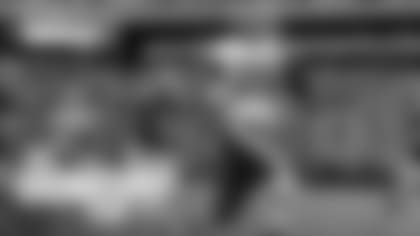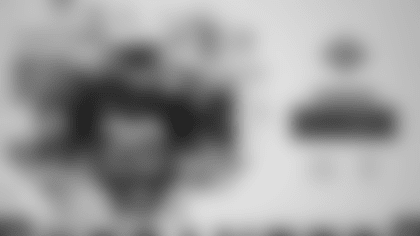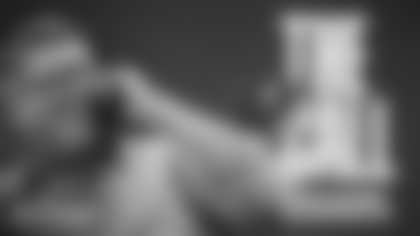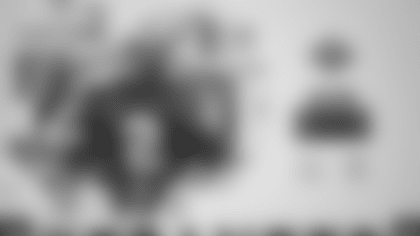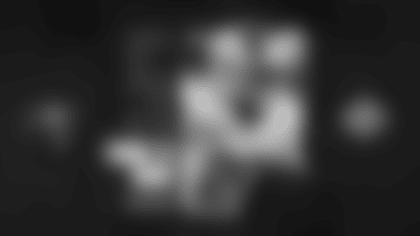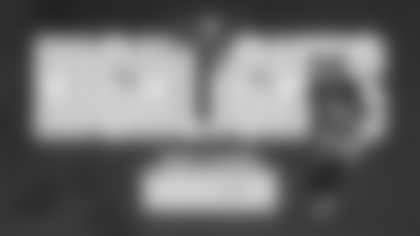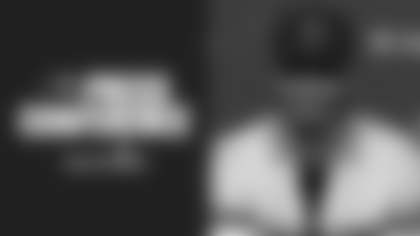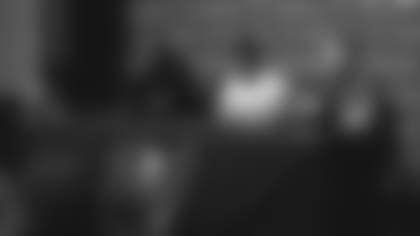Every team in the NFL does some things better than others. Some teams are particularly good at one thing, maybe even the best in the league. Think the New England Patriots and their play-action seam pass to the tight end. Or the Pittsburgh Steelers with the counter run. Or the Carolina Panthers' goal-line QB keeper.
None of these signature strengths are a secret. Opponents prepare for them in the film room and on the practice field, and yet these teams continue to succeed with the same concepts. That is, of course, often due to the presence of some especially skilled players, like Rob Gronkowski in New England, Le'Veon Bell in Pittsburgh and Cam Newton in Carolina. Still, these well-known plays generally require precise execution by many of the 11 players on the field. And when they work, they are often a thing of beauty, at least to football fans.
Each game week during Tampa Bay's 2018 regular season, we are going to look at a "Signature Play" that the Buccaneers upcoming opponent utilizes often and particularly well. With the help of images of a sample play at various points during its execution, we're going to try to understand why this play commonly works so well. This week, the opponent is the San Francisco Giants, who make use of the speed and athleticism of emerging-star tight end by getting him out in space with some misdirection.
SAN FRANCISCO 49ERS' SIGNATURE PLAY: BOOTLEG PASS TO TE GEORGE KITTLE
The 49ers have the NFL's third-most productive rushing attack, they are averaging a robust 4.7 yards per carry and they call for a run on 44.7% of their plays, the sixth-highest percentage in the NFL. They have an undrafted first-year quarterback at the helm, albeit one – Nick Mullens – who has been impressive in his first two NFL starts. No San Francisco wideout has more than 24 catches or 339 yards, and the team has been working through some injuries at that spot.
That does not mean, however, that the 49ers are lacking a dangerous weapon in the passing attack or are going to run the ball on every down Sunday at Raymond James Stadium. The emerging star in San Francisco's aerial attack is second-year tight end George Kittle, a former fifth-round draft pick who ranks third in the NFL at his position with 775 receiving yards. Kittle is averaging 15.5 yards per catch, an excellent mark for a tight end, and he is second in the NFL among all players with 539 yard gained after the catch (YAC).
Kittle ran a 4.51 40-yard dash at the 2017 NFL Scouting Combine but he lasted until the fifth round because he had relatively low production at Iowa (42 catches over his last two seasons) and it wasn't clear how strong of a blocker he would be in the NFL. Kittle arrived at Iowa as a 200-pound wide receiver.
What the 49ers got for their fifth-round investment is a fast and athletic tight end in the mold of a Zach Ertz or a Jordan Reed. He has been on the field for more than 80% of his team's offensive snaps in 2018 as the coaches have found inventive ways to get him open out in space so that he can use his speed and size to pick up all that aforementioned YAC.
One of those ways is a play-action bootleg rollout by the quarterback, with Kittle coming across the formation and bursting out into open field on the other side. That plan worked to perfection in Week Seven against the Los Angeles Rams.

The 49ers were overmatched for the most part on this day by the high-powered Rams, and they found themselves in a 22-0 hole as halftime approached. They got the ball back at their own 25 with 2:30 left in the second quarter and were able to mount a successful two-minute drive to put points on the board before the intermission.
The drive began with a tight end screen to Kittle – another play San Francisco uses a lot – out to the right side, with Kittle catching the ball at the 38 and tacking on 22 YAC for a 35-yard gain overall. That brought on the two=minute warning and the 49ers came out of the break with a plan to put the ball in Kittle's hands again.

The 49ers come out in "12" personnel, which means they have one running back, two receivers and two tight ends on the field. Wide receiver Marquise Goodwin (#11) is lined up on the right, just inside the numbers on a play that is being snapped from the right hash. Wide receiver Pierre Garcon (#15) is split out a little wider to the left.
Kittle (#85) lines up alongside the right tackle and fellow tight end Garrett Celek (#88) lines up on the opposite end of the line. However, Celek then goes in motion and will end up outside of Kittle on what becomes the strong side of the formation. Raheem Mostert (#31) is the lone running back, set up directly behind quarterback C.J. Beathard (#3).
The Rams counter with their base defense and are in man-to-man coverage with a single-high safety. The player who is responsible for Kittle if he goes out on a route is linebacker Mark Barron (#26), and in the picture above you can see that Barron has reacted to Celek's shift by switching sides with linebacker Corey Littleton (#58) so that Barron remains on the weak side of the formation.
Outside linebacker Samson Ebukam (#50), who is in a two-point stance outside the left tackle, is another defender who could stop Kittle's intended plan if he diagnoses the play quickly enough, which will see below that he does not. Matt Longacre (#96) essentially becomes the SAM linebacker when Celek settles in next to Kittle and would be responsible for covering Celek if he releases from the line.

At the snap, Mostert starts off towards the strong side of the formation on a slant and Beathard takes a couple steps in the same direction to set up an apparent handoff. Celek stays in to block Longacre and the entire offensive line flows to the right to help sell the play action.
Beathard, a good ball-handler, executes a very nice play-action fake that sells Ebukam rushing from around the right side of the line. He is not occupied by a blocker because left tackle Joe Staley (#74) is working on turning DE Michael Brockers (#90) in to the right.
Meanwhile, Kittle has gone out on his route. He doesn't bother to delay or chip defensive tackle Ndamukong Suh (#93) but quickly bends around Suh and starts running horizontally in front of the locked-up linemen, in front of Littleton and Barron. In the picture above, Kittle is hard to pick out because he is crossing right in front of the center, but the picture was taken at this point to show that Barron is just beginning to realize that Kittle has released and his turning his head in his direction. Barron realizes that Kittle is going out on a route but not before the tight end is running past him.
Goodwin also runs a route that takes him across the field from right to left, parallel with Kittle but about 10 yards deeper. This gives the play levels in case the defense sucks up towards Kittle and leaves Beathard a deeper option in Goodwin. Cornerback Troy Hill (#32) actually does a nice job of staying in close pursuit to Goodwin, and that will also take Hill into position to make a tackle at the end of the play.

After faking the handoff, Beathard bootlegs out to his left. The successful play-fake not only kept Ebukam from dropping into Kittle's lane across the field, but it also kept him from going directly after Beathard as he started to run. Beathard has plenty of room in which to maneuver and Kittle is all alone by the left hashmarks. Running and throwing to the left is not an easy task for right-handed quarterbacks, but Beathard is an accurate passer on short and intermediate throws, as is Mullens.
Garcon has helped create this space for Kittle by running a good, hard route up the field. He knows the play is not coming to him but he sells his route and gets enough depth to pull cornerback Marcus Peters (#22) out of the area. Barron is in pursuit but he's already beaten on the play. He, too, was fooled by the play-action fake as it made him flow to his left; had he moved forward towards the line, instead, he might have been able to disrupt Kittle's route between the linemen and the linebackers. Mostert deserves credit for his part of the fake as well, as he sold it nicely all the way up to where the blockers were engaged.

Kittle catches the ball on the run and turns quickly and smoothly into a ballcarrier, using his speed to eat up yards down the sideline before defenders arrive. He picks up 20 yards after the catch on a pass that only went three yards beyond the line of scrimmage. The last 11 of those YAC came after the contact as Kittle willingly lowered his shoulder to initiate contact with Hill, staying in bounds and fighting for every yard.
Kittle would be rewarded for his efforts at the end of the drive, as Beathard ended the drive with a touchdown pass to his tight end on third-and-goal from the 10 with 16 seconds left. Kittle caught the ball just across the line, a ruling that was reached after the play was reviewed. The Rams went on to win the game, 39-10, but it was the efforts of George Kittle that made San Francisco's one scoring drive possible.









